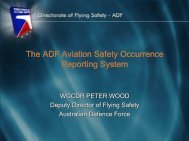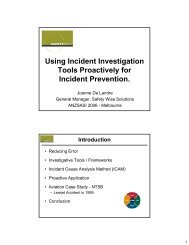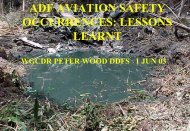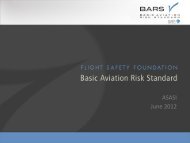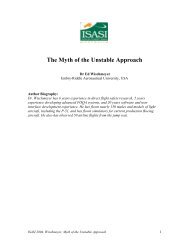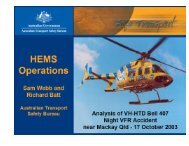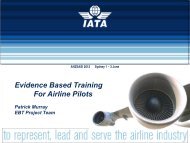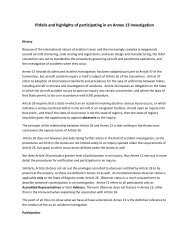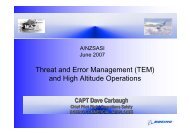communication in aviation safety: lessons learned and ... - ASASI
communication in aviation safety: lessons learned and ... - ASASI
communication in aviation safety: lessons learned and ... - ASASI
You also want an ePaper? Increase the reach of your titles
YUMPU automatically turns print PDFs into web optimized ePapers that Google loves.
due to poor <strong>communication</strong>. Thus, it is essential for accident <strong>in</strong>vestigators to have anunderst<strong>and</strong><strong>in</strong>g of the effects of <strong>communication</strong> <strong>in</strong> the <strong>aviation</strong> <strong>safety</strong> environment to beable to fully <strong>in</strong>vestigate the causes of an accident, whether primary or secondary.CONCLUSIONThis paper exam<strong>in</strong>ed the status of <strong>communication</strong> as a crucial aspect of <strong>aviation</strong> <strong>safety</strong>.Effective <strong>communication</strong> is essential for <strong>aviation</strong> <strong>safety</strong>, whether with<strong>in</strong> the cockpit, thecab<strong>in</strong>, ma<strong>in</strong>tenance, or between flight deck <strong>and</strong> other parts of the <strong>aviation</strong> system.Effective crew coord<strong>in</strong>ation is fundamentally dependent upon effective <strong>communication</strong>.Teach<strong>in</strong>g effective <strong>communication</strong> is an essential requirement for <strong>aviation</strong> <strong>safety</strong> tra<strong>in</strong><strong>in</strong>gfor all <strong>in</strong>volved <strong>in</strong> this enterprise. Short of ground<strong>in</strong>g all aircraft, it is probablyimpossible to elim<strong>in</strong>ate the risk of <strong>in</strong>effective <strong>communication</strong> lead<strong>in</strong>g to <strong>in</strong>cidents <strong>and</strong>accidents. However, it is possible to m<strong>in</strong>imize such risk by creat<strong>in</strong>g an awareness of theimportance of effective <strong>communication</strong>, <strong>in</strong>tegrat<strong>in</strong>g such awareness <strong>in</strong>to our th<strong>in</strong>k<strong>in</strong>g, <strong>and</strong>apply<strong>in</strong>g this <strong>in</strong>tegration <strong>in</strong>to a proactive approach to communicat<strong>in</strong>g by <strong>in</strong>corporat<strong>in</strong>geffective <strong>communication</strong> behaviors <strong>in</strong>to all aspects of the <strong>aviation</strong> <strong>safety</strong> environment.An article <strong>in</strong> the ASRA Directl<strong>in</strong>e perhaps said it best with regard to <strong>communication</strong> <strong>in</strong><strong>aviation</strong> <strong>safety</strong> when not<strong>in</strong>g that <strong>communication</strong> errors are the most frequently citedproblems <strong>in</strong> the <strong>in</strong>cidents that are reported to ASRS:Communication problems take a variety of forms. Equipment deficiencies,phraseology, similar call signs, speech rated, blocked transmission, <strong>and</strong> failure ofthe readback/hearback process are just a few types of <strong>communication</strong> problems.The subject is too broad to be covered by any degree <strong>in</strong> this article, but I do wantto make the po<strong>in</strong>t that <strong>communication</strong> problems often lead to a “FlawedInformation Transfer” (FIT), <strong>and</strong> if the flawed <strong>in</strong>formation transfer is notcorrected soon enough, the result may be an “Occasional Semi-HystericalInformation Transfer” (acronym unknown) (George, 1993, June, p. 16).26




